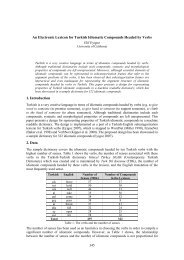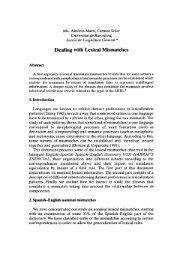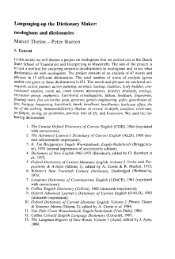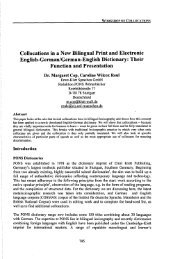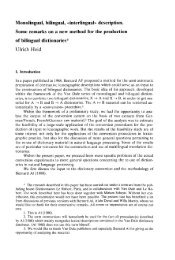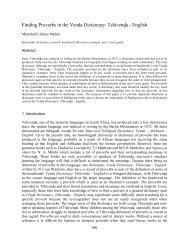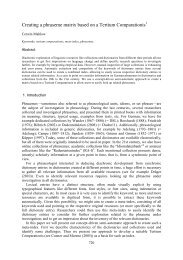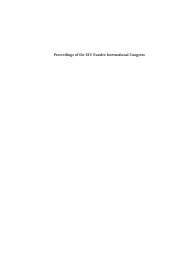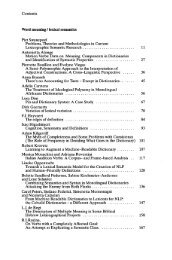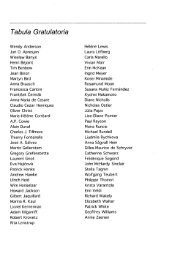Mary Snell-Hornby THE BILINGUAL DICTIONARY - HELP ... - Euralex
Mary Snell-Hornby THE BILINGUAL DICTIONARY - HELP ... - Euralex
Mary Snell-Hornby THE BILINGUAL DICTIONARY - HELP ... - Euralex
Create successful ePaper yourself
Turn your PDF publications into a flip-book with our unique Google optimized e-Paper software.
- 279 -<br />
This basic system aims at maximum simplicity and flexibility:<br />
the paradigms are represented in columns, the gaps with arrows<br />
indicating a transition or shift in perspective; horizontal arrows<br />
between the columns indicate a change in physical dimension. The<br />
structure of the field of size (Part 2), as represented by this<br />
sample, can be described as follows:<br />
The adjectives presented here all denote size relative to a<br />
hypothetical norm represented on the diagram by 0: lexemes to<br />
the left of 0 denote size exceeding this norm, those to the<br />
right, size falling short of it. The columns are arranged<br />
in descending order of size.<br />
The main section with the contrastive definitions (Part 3) would<br />
run as follows, and for clarity and brevity I have here included<br />
a few very simple examples (Part 4) within the text - authentic<br />
examples with the necessary co-text are usually longer and more<br />
complex, and hence should normally be listed separately as footnotes<br />
(cf. <strong>Snell</strong>-<strong>Hornby</strong> 1983:89 ff.):<br />
Large and small are antonyms indicating objective measure<br />
of size in excess of and in default of 0 respectively; these<br />
are the terms used in trade and official reports. Big and<br />
little are likewise antonyms indicating subjective impression<br />
o"f iTze; these are the words used in everyday language, by<br />
small children, in an emotive context, or to indicate a general<br />
impression. In an unstressed position, big can have an<br />
augmentative function ("Look at that greatbig dog!"), and<br />
little a diminutive function ("Look at that dear little<br />
puppy !") . In contrast to English, German has only one pair<br />
of antonyms, groft and klein, expressing both objective<br />
measurement and subjective impression of size. Gro@ has<br />
no augmentative function; this is expressed in German by<br />
compounds, e.g. Riesen- or riesengroft . Groft also extends<br />
to tall in expressing measurement ot human height. Great on<br />
the other hand indicates a subjective impression of extreme<br />
magnitude, either concrete ("He felt lost in the great city")<br />
or abstract, indicating evaluation ("Shakespeare was a great<br />
dramatist"). German riesig expresses the subjective impression<br />
of extreme magnitude only in the concrete sense ("Tokio ist<br />
eine riesige Stadt"), whereby it has the emphatic colloquial<br />
function of English huge. The abstract sense of extreme<br />
magnitude, on the other hand, is expressed by gro p ("Er war<br />
ein groPer Schriftsteller").<br />
Conclusion<br />
This short description obviously could not aim at exhausting<br />
all the semantic and syntactic properties of the lexemes concerned,<br />
and the problem of maximum economy in presentation also remains<br />
to be solved, but I hope to have given some evidence for my conviction<br />
that the bilingual dictionary will not fulfil its function<br />
completely if it remains merely a repository of isolated lexemes<br />
and static equivalents - it also needs to reveal the dynamic<br />
system of relationships within and between languages, the function<br />
of words in their contexts, and the interdependence of language,<br />
culture and social interaction.



